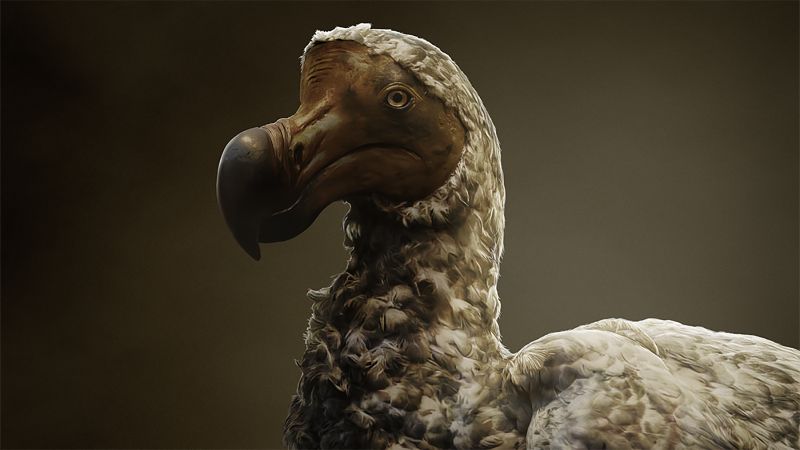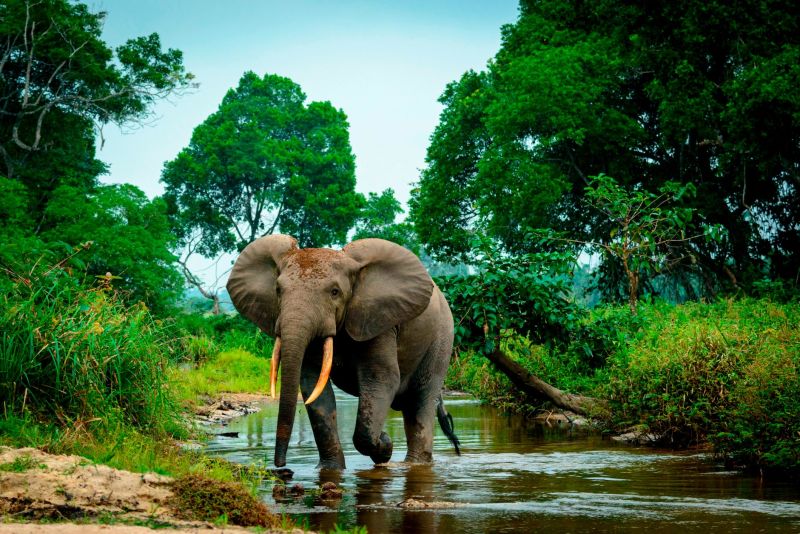
Reviving the Past: Reintroducing the Dodo Bird to Mauritius

Revolutionary de-extinction project seeks to resurrect the iconic dodo bird, extinct for centuries, and reintroduce it to its original homeland in Mauritius A unique collaboration between geneticists and conservationists aims to revive this lost species and restore ecological balance
Geneticists and conservationists are boldly collaborating to revive the extinct dodo and release it back into its original habitat in Mauritius. Colossal Biosciences, a biotech company in the US, is partnering with the Mauritian Wildlife Foundation to identify the best location for reintroducing the large flightless birds as part of their efforts to "de-extinct" multiple species, such as the woolly mammoth.
The dodo, extinct since 1681 due to predation by humans and introduced animals, is being considered for resurrection in Mauritius. Colossal revealed its plans to bring back the species in January 2023, with further details on the process to follow.
Beth Shapiro, the lead paleogeneticist at Colossal, has successfully sequenced the full genome of the dodo. Furthermore, the company has also completed the genome sequencing of the solitaire, an extinct relative of the dodo from Rodrigues Island near Mauritius, as well as the Nicobar pigeon, the closest living relative of the dodo, found on islands across the Indian and Pacific Oceans.
The Nicobar pigeon, native to the coastal regions from the Andaman and Nicobar Islands, is the closest living relative to the dodo.
Arterra/Universal Images Group/Getty Images
Geneticists at Colossal have discovered that cells with the potential to become ovaries or testes in the Nicobar pigeon can successfully develop within a chicken embryo. They are now conducting research to determine if these cells, known as primordial germ cells (PGCs), have the ability to develop into viable sperm and eggs.
This discovery is a crucial advancement in the efforts to create hybridized animals through reproduction. In previous experiments, scientists successfully introduced PGCs to produce a chicken sired by a duck, by injecting chicken PGCs into a duck embryo. This resulted in an adult duck with the sperm of a rooster, which then mated with a hen to produce a chick.
Colossal plans to take a similar approach by first comparing the genomes of the dodo and solitaire to those of the Nicobar pigeons in order to identify their differences. The next step will be to edit the PGCs of a Nicobar pigeon to express the physical traits of a dodo.
Once the PGCs have been edited, they will be inserted into the embryos of a sterile chicken and rooster. With the introduction of the edited PGCs, the chicken and rooster will gain the ability to reproduce, and theoretically, their offspring will exhibit traits resembling those of the dodo, thanks to the hybridized pigeon DNA in their reproductive systems.
Matt James, Colossal's chief animal officer, stated in an email that the restored dodo will be physically indistinguishable from what is known about the appearance of the dodos. He described the project as an incredible driver of innovation for avian genetics, genomics, and cell biology, noting that most of the cloning technologies used in mammals do not currently exist in birds. However, he refrained from providing a timeline for the creation of the first embryo.
Building a new home for the dodo
Black River Gorges National Park, Mauritius.
Holger Hollemann/dpa/picture alliance/AP
While Colossal's laboratory is still conducting research, the team at the Mauritian Wildlife Foundation (MWF) will be focused on creating a suitable environment for the birds. Vikash Tatayah, the director of conservation at the foundation, revealed that MWF has initiated a partnership with Colossal earlier this year, and is currently working on a feasibility study to determine the best location for the birth of Colossal's birds.
"Mauritius is a relatively small island, measuring 60 kilometers by 30 kilometers," Tatayah pointed out. "A significant portion of its land has been taken over by sugar cane, buildings, villages, and reservoirs."
He also mentioned that there is no perfect site, as each potential location comes with its own advantages and disadvantages, including the presence of predators, poaching, and other forms of human interference.
Black River Gorges National Park, along with other nearby nature reserves like Round Island and Ãle aux Aigrettes, is under consideration for the potential relocation of Colossal Dodo. These locations, unlike the mainland, are free from natural predators, making them favorable for the thriving of the Dodos. Additionally, the foundation is interested in a location where the Dodos can be visible to the public, and both Round Island and Ãle aux Aigrettes are currently uninhabited. However, on the mainland, invasive species like rats, feral cats, pigs, dogs, monkeys, mongooses, and crows may need to be "excluded, rehomed, or even controlled" to create a suitable habitat for the Dodos.
There is the possibility the dodo will be reintroduced at multiple locations, he added.
The protected island of Ile Aux Aigrette in the Indian Ocean, close to Mauritius, is one potential location for Colossal's dodos.
Ben Birchall/PA/AP
Once human influences and alien predators are managed, Tatayah is less worried about the dodo's reintegration into its environment. He stated, "It was coexisting and coevolved with other birds, other plants and reptiles ... so I can't see them being competitive at all."
In fact, he contended that there could even be additional advantages, pointing to "mutualistic relationships which have broken down since the loss of the dodo."
The large beak of the bird indicates that it ate large-seeded fruits, and the dodo contributed to the dispersal of seeds. Some of these plant species are at risk or highly threatened, with one possibility being that the seeds are not being dispersed and prepared for germination without the dodo and other extinct large species (such as the domed Mauritian giant tortoise).
Tatayah stated, "I believe the dodo will greatly benefit the restoration of ecosystems."
A rendering of a woolly mammoth. Biotech company Colossal wants to revive the mammoth by creating a hybrid combining its DNA with that of Asian elephants.
Courtesy Colossal
Using AI to monitor orphaned elephants in Botswana could usher in the return of the woolly mammoth
Despite the possibility of the dodo playing a role in seed dispersal, Julian Hume, an avian paleontologist at the Natural History Museum in London, urges caution. According to Hume, there is still very little information available about the dodo, making it impossible to determine its interactions with the environment.
"Colossal's idea is a good one," he stated. "But due to the complexities of creating a species from DNA, even if possible, it would likely only result in a creature similar to the dodo. It would then take years of selective breeding to transform a small pigeon into a large flightless bird. Keep in mind, it took nature millions of years for this to occur with the dodo."
Regarding studying the bird once it is reintroduced, Hume stated, "At best, Colossal could only produce a bird with some dodo-like qualities, and a bird that lacks natural instincts for living in the wild. It would be premature to draw any conclusions about behavior or other life history traits based on it."
Why revive the dodo at all?
An illustration of a dodo, created by Colossal Biosciences.
courtesy Colossal Biosciences
Why invest in reviving the dodo, a long-extinct, flightless bird and confining it to an island in the middle of the Indian Ocean? Ben Lamm, CEO and co-founder of Colossal, believes that bringing back the dodo presents the chance to foster hope for conservation efforts, particularly among the younger generation, amidst a time of environmental challenges and political turmoil.
Tatayah is of the opinion that the innovative techniques developed by the dodo project could be instrumental in the restoration of other bird species. He also believes that the high-profile nature of the project could serve as a catalyst for broader conservation initiatives in Mauritius. "From our observations, when you embark on the journey of saving a species, it sparks the motivation to safeguard and rehabilitate habitats and ecosystems," he stated.
"Were interested in entire ecosystem conservation. We dont want to find the dodo alone in a field," Tatayah added.
A photo of an African forest elephant (Loxodonta cyclotis) in Lekoli River, Odzala-Kokoua National Park, Cuvette-Ouest Region, Republic of the Congo. (Credit: Education Images/Universal Images Group via Getty Images)
Sub-Saharan Africa has recently achieved the milestone of 100 World Heritage Sites, but UNESCO believes that the number falls short of what is actually necessary.
According to the director of the Mauritian Wildlife Foundation, the potential return of the dodo is not a swift process, stating that "it's not going to happen overnight... we're talking about probably a decade." He explained that the birds would need to be created in the US and then imported, emphasizing the legal and political complexities of the project, which could lead to significant delays over the years.
Tatayah emphasized the importance of not relying solely on "de-extinction" technologies, but instead using them as an additional conservation tool alongside traditional methods. He described it as "another tool in the toolbox but not the tool that replaces the whole toolbox."
Hume supported this idea, suggesting that the substantial investment in Colossal could be better utilized to aid other endangered species through more conventional conservation efforts.
The paleontologist supports the de-extinction movement, particularly for recently extinct species like the Thylacine (Tasmanian tiger) and species with non-viable populations such as the Northern White Rhino, which only has two remaining females. (Colossal Biosciences is conducting research into both.)
"Dodo, despite being a regrettable case of human-caused extinction, is a thing of the past," stated Hume. However, our ongoing curiosity persists.
"I have studied the dodo for many years, and there is still a lot to learn about this enigmatic bird," he added. "If one was ever recreated, I would certainly be the first in the queue to see it."












